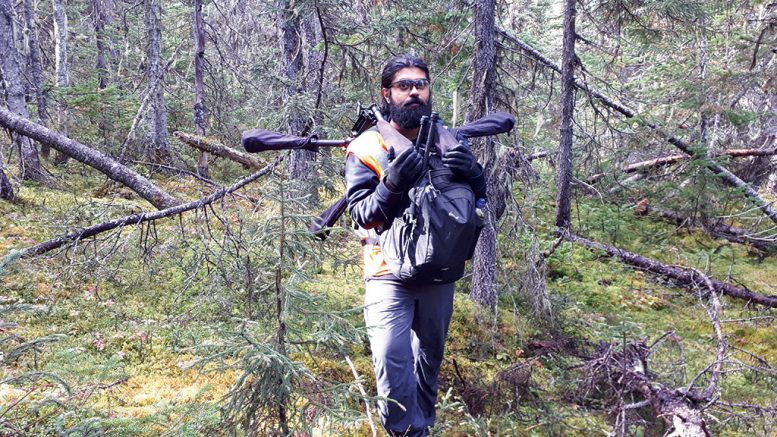Junior explorer Supreme Metals (TSXV: ABJ) has found a large, magnetic anomaly on its Bloom Lake East property in Labrador, 2.5 km east of Champion Iron Mines’ (TSX: CIA) flagship Bloom Lake open-pit iron ore mine and mill, near Fermont in Quebec.
The 2.5 km long magnetic anomaly, defined in a recent magnetometer survey done by drone, is 15 km from the Wabush iron ore mines of Iron Ore Co. of Canada and managed by Rio Tinto (NYSE: RIO; LON: RIO). The survey produced 462 line km of data.
The triangular shaped anomaly that covers an area of 2.5 by 2.5 by 1.5 km contains the Nip Lake West Occurrence, a stratabound, Superior-type iron formation the company already knew existed. A grab sample taken from Nip Lake in 1979 returned 59.9% soluble iron. “We assumed Nip Lake was a small body and didn’t know much about it,” Bob Komarechka, the company’s CEO and a geologist, tells The Northern Miner in a telephone interview from his home in Sudbury.
“It’s an area known for iron formations, but we were quite surprised we had such a large anomaly so close to a mine site,” he says. “It’s been folded over onto itself, but what the grade is of those bands I don’t know, so it’s speculative at this point to say we have ore, but it’s definitely an anomaly that should be followed up on, and may have significance.”
Previous work in the area was not definitive, so Komarechka completed a magnetic survey because he was also interested in gabbros and potential cobalt on the property.
Indeed, it was the property’s cobalt potential that prompted Supreme Metals to acquire 84 claims (21 sq. km) in Bloom Lake East in February 2017.
Since finding the anomaly in December, the company has added 21 claims (5.3 sq. km) for a total of 26.3 sq. km of ground.
The cheapest way to evaluate the property for any gabbroitic cobalt bodies and iron formation is by drone, he says, because his firm doesn’t have to cut lines and it can get high-resolution data from 50 metres above surface.

A surveying drone and a helicopter at a launch site on Bloom Lake East. Credit: Pioneer Aerial Surveys.
The only challenging part of the surveying, he recalls, was the 25 km winds that would hold up the drone work from time to time.
The company will continue to explore the anomaly, as well as look for gabborites containing cobalt.
“We don’t have enough information on cobalt at the moment but we do have a significant magnetic anomaly, and the occurrence on an iron property suggests the potential for something of significance,” Komarechka says.
The Bloom Lake East property was previously owned by Iron Ore Co. of Canada, a joint venture between Rio Tinto (58.7%), Mitsubishi (26.2%) and Labrador Iron Ore Royalty Income Corporation (15.1%).
The Iron Ore Co. of Canada had been carrying out geophysical surveying on the property, but as low iron ore prices fell, it cut back on exploration and dropped its claims, Komarechka says.
The new owners pitched the property to Supreme Metals as a cobalt play, as exposed cobaltite had been discovered in a gabbro unit west of Bloom Lake on the neighbouring ground of another company, which contained historic grab samples grading 6–6.5% cobalt.
Bloom Lake East benefits from infrastructure in the region. It is bisected by a railway that services the Labrador Trough and the Port of Sept-Îles. There is also a road 500 metres from the property.

A launch and observation site during the UAV survey at Bloom Lake East. A UAV operator must be in direct visual contact with the drone in flight. Credit: Pioneer Aerial Surveys.
Komarechka notes that the company also has benefited from its location in Newfoundland and Labrador, where the government, through its Junior Exploration Assistance Program, can, if approved, reimburse up to 75% of a company’s exploration expenses.
“It’s a pool, so anyone who wants to can apply,” he says. “It’s a great program to encourage exploration, especially in remote areas like Labrador. When you’re working in areas out in the boonies, there’s more risk. And if you have incentives like this, you can make it happen.”
At press time, Supreme Metals was trading at 2¢ per share within a 52-week range of 1.5¢ to 8¢. It has 179 million shares for a $3.6-million market capitalization.


Be the first to comment on "Supreme Metals pinpoints large, near-surface anomaly"